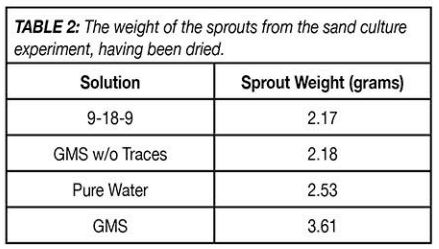Sand Culture Experiment
Unlike the hydroponics experiment, the corn sprouts in this experiment were grown in a soil medium with some mineral nutrition naturally available. However, a similarity is that neither had any detectable soil microbiology, which means that nutrient absorption would be completely the roots' responsibility. The sand would have had a small buffering capacity against impurities, but as you can see from the 9-18-9 vial in Photograph B (see below), it clearly isn't enough. Sand soils have a lot of pore space due to each sand particle's relatively large size, so a lack of root penetration is typically not as much of a concern as in clay soils. Again, there was a significant difference amongst the vials in root growth and top growth. The regular GMS outperformed all of the other vials. In this experiment however, the vial that performed the worst was actually the 9-18-9. I will discuss why these observations are below.
SAND CULTURE DISCUSSION
The first topic I want to cover is the performance of the 9-18-9 vial. As stated in the previous article, the 9-18-9 was selected for these experiments because it has performed the next best to GMS in past experiments. I believe that what we are seeing in Photograph B is the result of the impurities in the 9-18-9. Recall that the sand was watered once with 125 milliliters of the 500-1 fertilizer dilution, which would have seeped through the sand. What we are seeing is the roots trying to avoid the toxic fertilizer solution in the sand. Notice that this did not occur in any of the other vials. Perhaps somewhat surprisingly, the purity of the fertilizers seems to have had a larger effect on growth in this experiment than the hydroponics one. Besides the 9-18-9 vial, this can also be seen in the similar results from the GMS without micronutrients and the pure water vial. Surprisingly, the pure water sprout actually outweighed the 9-18-9 and GMS without micronutrients' vials. I can't be sure as to why this is, but it may have something to do with sand clinging to root hairs, as was seen with the regular GMS sprout.
Secondly, let's take a look at the regular GMS sprout. It outperformed all of the other vials in both root and top growth again, though this time to a lesser extent. This is because of a combination of cleaner raw materials and micronutrient availability. Again, the only difference between it and the GMS without micronutrients is the micronutrients package.
Finally, and to conclude, both of these experiments should that 1) GMS contains an available micronutrients package; 2) GMS is made with higher quality raw materials than at least one competitor fertilizer; 3) micronutrients are an important part of germination and early growth; 4) clean raw materials are an important characteristic of liquid fertilizers; and 5) using a clean fertilizer is important whether there is soil present or not.
This is an excerpt from the Winter Growers Solution (2023) written by Zach Smith, Product and Training Specialist.
Signup for our newsletter to stay in the loop


